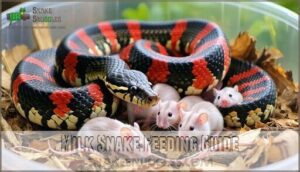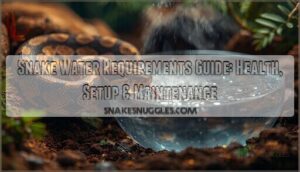This site is supported by our readers. We may earn a commission, at no cost to you, if you purchase through links.

Start with an enclosure that’s secure and sized appropriately—at least 20 gallons for adults.
Use a safe substrate like aspen shavings, and provide hiding spots for comfort.
Maintain a temperature gradient of 75-85°F, with a basking spot around 88°F.
Humidity should stay at 40-60%, so mist lightly as needed.
Feed them appropriately sized frozen-thawed rodents once a week.
Handle gently and allow time for them to trust you.
Clean the enclosure regularly to prevent health issues.
With proper care, these colorful snakes thrive and make fantastic, low-maintenance pets!
Table Of Contents
- Key Takeaways
- Milk Snake Enclosure Setup
- Temperature and Humidity Management
- Milk Snake Feeding Guide
- Milk Snake Health and Hygiene
- Handling and Interacting
- Milk Snake Care and Maintenance
- Frequently Asked Questions (FAQs)
- What is the best bedding for milk snakes?
- Are milk snakes good for beginners?
- Are milk snakes high maintenance?
- What size cage does a milk snake need?
- Are milk snakes easy to handle?
- Do milk snakes need a vet?
- How do you care for a milk snake?
- How to care for a Nelson’s milk snake?
- How long do milk snakes typically live in captivity?
- Can milk snakes recognize their owners?
- Conclusion
Key Takeaways
- Set up your milk snake’s enclosure with a secure 40-gallon habitat, aspen substrate, multiple hiding spots, and proper ventilation to create a comfortable environment that supports their natural behaviors.
- Maintain a temperature gradient of 75-85°F with a basking spot of 88°F, and keep humidity between 40-60% using a hygrometer to monitor levels, adjusting with misting as needed for healthy shedding.
- Feed your milk snake appropriately sized frozen-thawed rodents once a week for juveniles or every 10-14 days for adults, ensuring prey isn’t larger than the widest part of your snake’s body.
- Handle your milk snake gently and infrequently at first to build trust, watching for stress signals like excessive hiding or refusal to eat, and clean their enclosure regularly to prevent health issues.
Milk Snake Enclosure Setup
Setting up the right enclosure is essential for your milk snake’s comfort and health.
With the right size, substrate, hiding spots, and ventilation, you can create a secure and inviting habitat.
Choosing Right Enclosure Size
Choosing the right milk snake enclosure is key to their health and happiness.
Match the enclosure size to the snake’s length.
- Hatchling enclosures: Use a 10-gallon terrarium.
- Adult enclosures: Provide at least 40 gallons, upgrading as they grow.
- Subspecies size: Larger snakes need bigger habitats.
- Space requirements: Make certain plenty of room for exploration and thermoregulation.
You can find various options for milk snake habitats.
Selecting Suitable Substrate
Your milk snake deserves a comfortable base. Choose a substrate that’s safe, retains moisture, and supports natural digging behaviors.
Shredded aspen, organic topsoil, or coconut fiber work well. Avoid cedar—it’s toxic! Think of the substrate like your snake’s cozy rug, but replace it every few months.
Many owners purchase snake aspen bedding for their reptile enclosures. Here’s a quick comparison:
| Substrate Type | Moisture Retention | Odor Control | Digging Support |
|---|---|---|---|
| Shredded Aspen | Low | Moderate | Excellent |
| Organic Topsoil | High | Moderate | Great |
| Coconut Fiber | Medium | High | Good |
| Newspaper | None | None | Poor |
| Reptile Carpet | None | None | None |
The choice of substrate is crucial for your snake’s health and well-being, and it should be selected based on its ability to retain moisture, control odor, and support natural digging behaviors.
Providing Hiding Spots
A cozy snake habitat needs secure hides for your milk snake to feel safe and reduce stress.
Provide multiple hides, using materials like cork bark or plastic boxes, and place them on both cool and warm sides of the enclosure.
Regularly clean these snake hiding places to prevent odor buildup, as hiding spots offer essential environmental enrichment, boosting overall milk snake care with secure hides.
Ensuring Proper Ventilation
Good airflow isn’t just nice; it’s a must for milk snake care.
Poor ventilation can trap stale air, causing mold and humidity spikes that harm your snake’s habitat.
Use enclosures with vents or mesh tops to prevent this.
Wooden vivariums work well, while glass ones may need extra ventilation methods to maintain proper temperature and humidity, ensuring good airflow.
Temperature and Humidity Management
Maintaining the right temperature and humidity is essential for your milk snake’s comfort and health.
By creating a proper thermal gradient and monitoring moisture levels, you’ll help your snake thrive in an environment that mimics its natural habitat, ensuring the overall health of your pet.
Creating Thermal Gradient
Creating a thermal gradient is key for milk snake care.
Set up a basking spot around 88-92°F and a cool zone at 75-80°F. Use heat sources like halogen bulbs and control them with a thermostat.
Guarantee a nighttime drop to 70-75°F for natural comfort.
A proper temperature gradient lets your snake thrive, promoting digestion and activity.
Regulating Temperature
To meet your milk snake’s temperature needs, maintain an 85-90°F basking spot with a cool side at 75-80°F.
Use reliable heat sources, like halogen bulbs, and control them with a thermostat for safety. Consider a snake halogen bulb for superior heat.
Nighttime heat can drop to 70-75°F. Temperature monitoring is vital, so invest in accurate thermometers to guarantee your snake’s thermoregulation stays on point.
Maintaining Humidity Levels
To keep milk snake humidity between 40-60%, use a hygrometer for humidity measurement.
Add a humid hide filled with moistened sphagnum moss for shedding success. Choose a substrate that holds moisture, like soil, and adjust substrate moisture to fit snake hydration needs.
Milksnakes also benefit from UVB lighting exposure for ideal health.
Proper snake humidity levels promote healthy skin, so misting frequency should balance moisture without overdoing it to ensure optimal care.
Misting and Monitoring
Proper humidity keeps your milk snake healthy.
Mist your enclosure 1-2 times daily to maintain 40-60% humidity. Use a digital probe hygrometer to track levels.
Watch for signs like poor shedding or labored breathing, which might indicate incorrect humidity.
Add moisture to the substrate or a humid hide if needed. Hydration guarantees smooth shedding and supports respiratory health, ensuring proper humidity levels.
Milk Snake Feeding Guide
Feeding your milk snake properly is key to keeping it healthy and thriving.
You’ll need to pick the right prey items, verify they’re the correct size, and follow a safe feeding routine.
Choosing Right Prey Items
A healthy milk snake diet starts with selecting quality prey.
Frozen-thawed prey is the safest choice, reducing handling feeding issues like injuries.
Look for prey with good nutritional value and source it ethically.
Mice are typical, but snake diet variety matters—rotate with other small rodents occasionally.
Supplementing prey items guarantees balanced nutrition and helps prevent health concerns like impaction.
Determining Prey Size and Frequency
Regarding milk snake feeding, picking the right prey size is key.
Choose prey no larger than the snake’s widest point to avoid health risks like obesity or regurgitation.
Hatchlings typically eat every 5-7 days, while adults do well on a 10-14 day feeding schedule.
If your snake refuses food, check temperature, stress levels, or prey variety.
Frozen Vs Live Prey
Choosing between live prey and frozen-thawed prey affects your milk snake’s feeding experience.
Frozen prey reduces parasite risk and handling dangers while addressing ethical concerns in your snake’s diet.
Live prey may stimulate natural hunting instincts but carries Nutritional Differences and higher risks.
One advantage to live prey is that it can encourage natural behavior.
Prey acceptance varies, but most milk snakes adapt well to frozen-thawed options, making them safer and more convenient, which also supports their dietary needs.
Feeding Tips and Precautions
When managing snake feeding, choose prey size slightly smaller than your milk snake’s widest body part.
Feed frozenthawed prey to reduce regurgitation risks and avoid live feeding unless necessary.
Adjust feeding frequency based on age—hatchlings weekly, adults biweekly.
Thaw frozen prey completely before feeding to prevent digestive issues.
Monitor your snake’s diet and behavior for signs of overfeeding or stress.
Milk Snake Health and Hygiene
Keeping your milk snake healthy starts with understanding their unique care needs, like proper shedding and a clean enclosure.
Regular monitoring helps you spot potential health issues early, ensuring your pet stays happy and active.
Recognizing Shedding Patterns
You’ll notice milk snakes’ pre-shed signs like dull skin or cloudy eyes.
This happens every few weeks or months, depending on shedding frequency.
A healthy shed should come off in one complete piece.
Retained shed, like bits stuck to the tail, signals snake shedding issues.
Increase humidity slightly to help with snake skin care and avoid shedding problems.
Monitoring Health Issues
Keep an eye on your milk snake’s health by spotting issues early.
Shedding problems, scale rot, or parasites like mites can signal trouble.
Watch for obesity signs or injuries, and make certain good nutrition to prevent deficiencies.
Regular vet checkups help catch internal problems.
Healthy snakes stay active—if yours isn’t, it’s time for an injury assessment or check.
Mites can be prevented with regular enclosure cleaning to ensure good nutrition and overall healthy snakes.
Preventing Respiratory Infections
Good snake husbandry helps prevent respiratory infections.
Watch for signs like wheezing or mouth bubbles.
Guarantee proper ventilation, as stuffy enclosures harm snake health.
Maintain humidity control to avoid extremes—too dry or damp can stress snakes.
Consistent temperature stability is key.
Quarantine newcomers to protect your milk snake.
A healthy, well-shed snake thrives in balanced reptile care with proper ventilation.
Maintaining Clean Enclosure
A clean enclosure is key to your milk snake’s health.
Remove waste, feces, and urates daily to prevent contamination. Replace soiled substrate, and refresh water bowls for proper sanitation.
Disinfect surfaces weekly using snake-safe methods to prevent mold growth. Use quality snake care substrate options to simplify substrate changing.
These steps help maintain cleanliness and promote a healthy, happy snake environment.
Handling and Interacting
Handling your milk snake correctly builds trust and keeps both you and the snake safe. Learning the right techniques helps reduce stress for your pet and guarantees a positive experience.
Getting Snake Accustomed to Handling
When starting milk snake handling, focus on a gradual introduction.
Give your snake time to settle in before any interaction.
Initial handling sessions should be short, reducing stress and building trust.
Use positive reinforcement by being calm and gentle.
Limit handling frequency to a few times weekly at first, gradually increasing as your snake becomes more comfortable.
Safe Handling Techniques
When handling your milk snake, always use gentle handling techniques and support its entire body to avoid injury.
Recognize cues like hissing or coiling, which signal stress.
Handling frequency should start low, gradually increasing trust over time.
Wash your hands before and after handling for good hygiene practices, and avoiding bites means staying calm and respecting your snake’s comfort levels at all times.
Building Trust and Confidence
Building trust with your milk snake takes patience and consistent interaction.
Gradual introduction is key—start by sitting near its enclosure to get it used to your presence.
Use positive reinforcement through gentle handling sessions, and watch its body language, recognizing cues like a calm temperament.
Avoid stressors, like sudden movements, to create a safe environment.
These snake care handling tips build confidence.
Recognizing Stress and Anxiety
Your milk snake’s body language speaks volumes about its stress levels.
Watch for these stress indicators: quick movements when handled, excessive hiding, refusal to eat, and incomplete shedding.
Milk snakes are naturally shy and should be housed alone to prevent competition and anxiety.
Always provide multiple hiding spots where they can retreat when feeling threatened.
Remember, these crepuscular creatures prefer limited daytime handling for ideal snake welfare.
Excessive handling can lead to increased hiding behavior.
Milk Snake Care and Maintenance
You’ll need to maintain your milk snake’s habitat regularly by cleaning the enclosure, monitoring temperature and humidity levels, and providing fresh water daily.
Consistent care routines will help prevent common issues like mites, respiratory infections, and incomplete shedding while ensuring your colorful companion remains healthy and active for many years.
Cleaning and Disinfecting Enclosure
While maintaining cleanliness is essential for your milk snake’s health, regular enclosure cleaning prevents harmful bacteria growth.
Remove fecal matter, urates, and contaminated substrate daily through spot cleaning. Replace the entire substrate monthly, washing all accessories with reptile-safe disinfectant.
Clean the water bowl every 2-3 days to prevent mold. Consistent substrate replacement and proper disinfectant selection create a healthy environment for your snake, ensuring regular enclosure cleaning is crucial.
Monitoring Temperature and Humidity
With regular enclosure cleaning complete, you’ll need to stay vigilant about your milk snake’s environmental conditions.
Check temperature requirements daily using infrared thermometers at both warm (85-90°F) and cool ends (70-80°F), and perform thermostat calibration monthly to maintain accuracy.
Digital hygrometers should show 40-60% humidity levels, and remember that snake humidity control needs seasonal adjustments—slightly higher in winter, lower in summer.
Create humidity retreats using moistened sphagnum moss for shedding periods, which is crucial for your milk snake’s health and well-being, especially during periods of shedding periods.
Providing Fresh Water and Hides
While checking temperature readings, don’t forget about water and hiding spots.
Your milk snake needs a heavy, tip-resistant water bowl large enough for drinking but not soaking.
Place it away from heat sources to prevent rapid evaporation.
Provide at least two hides—one on the warm side, one on the cool side—made from wood, cork, or commercial reptile hides.
A humidity hide filled with damp moss helps during shedding periods.
Troubleshooting Common Care Issues
While providing fresh water daily is essential, you’ll occasionally face issues with your milk snake.
Watch for these common problems:
- Refusal to eat – often related to stress, improper temperatures, or during shedding
- Shedding problems – incomplete sheds indicate low humidity
- Scale rot or mite infestations – typically result from poor hygiene
If your snake regurgitates, wait 10-14 days before offering food again.
Proper hydration and occasional supplements will prevent most health concerns.
Regular enclosure cleaning can help prevent mite and tick infestations.
Frequently Asked Questions (FAQs)
What is the best bedding for milk snakes?
Picture your milk snake nestled comfortably in its home.
You’ll want aspen shavings as your go-to bedding—it’s perfect for burrowing and maintains lower humidity that milk snakes prefer.
For baby snakes, paper towels work best until they’re juveniles.
Are milk snakes good for beginners?
Yes, milk snakes make excellent beginner pets.
They’re docile, stay relatively small, don’t require complicated setups, and have simple feeding needs.
You’ll find their beautiful patterns and manageable care requirements perfect for your first reptile experience.
Are milk snakes high maintenance?
While 90% of snake species require complex care, milk snakes rank among the lowest maintenance options.
You’ll only need to feed them every 5-7 days and clean their enclosure monthly.
They’re perfect for busy owners.
What size cage does a milk snake need?
Adult milk snakes need a minimum 40-gallon enclosure (36"x18"x18"), while larger specimens require up to 70 gallons.
You’ll want to provide at least one square foot of floor space per foot of snake.
Are milk snakes easy to handle?
Many beginner keepers find milk snakes quite manageable.
They’re generally calm, rarely bite, and will become comfortable with regular, gentle interaction.
Start with short sessions and appreciate their docile nature once acclimated to handling.
Do milk snakes need a vet?
Like all reptiles, your milk snake needs regular veterinary check-ups with an exotic pet specialist.
You’ll want annual wellness exams and immediate care if you notice unusual behavior, appetite changes, or breathing issues.
How do you care for a milk snake?
Provide your milk snake with a secure 40-gallon enclosure.
Maintain a 78-86°F temperature gradient, and offer weekly frozen mice.
Keep humidity at 40-60%, and make certain a clean habitat with proper hides and fresh water.
How to care for a Nelson’s milk snake?
You’ll need a 40-gallon enclosure with secure lid, temperatures of 78-86°F, 40-60% humidity, and substrate like aspen.
Feed frozen mice every 7-10 days and handle your Nelson’s milk snake gently.
How long do milk snakes typically live in captivity?
These colorful companions are marathon runners, not sprinters.
With proper care, you’ll enjoy your milk snake’s company for 15-20 years, though some can live even longer if you maintain ideal conditions.
Can milk snakes recognize their owners?
Milk snakes don’t truly recognize owners, but they’ll become accustomed to your scent and handling over time. They’re not social animals, so they won’t bond with you like mammals do.
Conclusion
Following your milk snake care guide guarantees a healthy, happy, and long-lived reptile companion.
You’ll find these colorful serpents thrive with minimal intervention when their basic needs are met.
Remember, consistent temperatures, proper humidity, and a secure habitat form the foundation of good snake care.
With regular feeding, gentle handling, and routine maintenance, your milk snake will reward you with fascinating behavior and striking beauty for up to 20 years!












